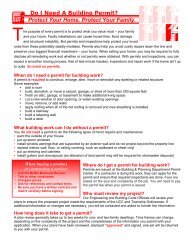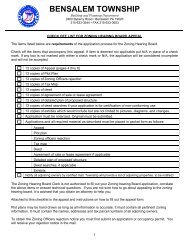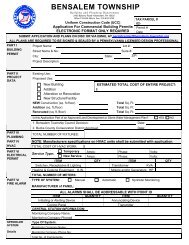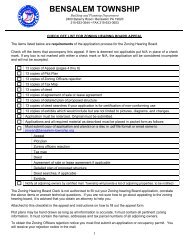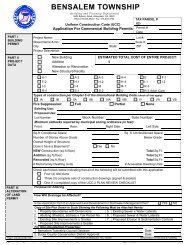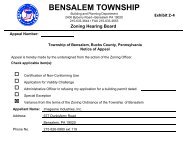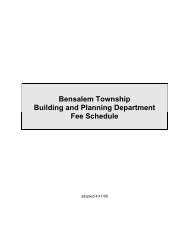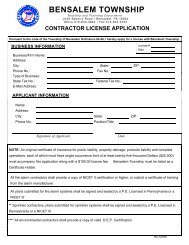Swimming Pool Water Discharge Guidelines
Swimming Pool Water Discharge Guidelines
Swimming Pool Water Discharge Guidelines
Create successful ePaper yourself
Turn your PDF publications into a flip-book with our unique Google optimized e-Paper software.
SWIMMING POOL WATER DISCHARGE GUIDELINES<br />
<strong>Water</strong> from swimming pools and hot tubs often contain high levels of chlorine. Discharging chlorinated pool/spa<br />
water into streams, (or irrigation canals, ponds, etc.) is harmful to fish and other aquatic life. The discharge of any<br />
sewage or industrial waste, including swimming pool water, to a water of the Commonwealth without a permit is a<br />
violation of the Clean Streams Law, the Act of June 22, 1937, P.L. 1987, as amended.<br />
It has been the Department’s policy not to require permits for discharges from single residence pools, provided<br />
the guidelines outlined below are followed. Local municipalities should be contacted concerning local ordinances.<br />
These guidelines shall not be construed so as to waive or impair any rights of the Department of Environmental<br />
Protection to prosecute the property (pool) owner and/or pool company for any stream damage that occurs as a<br />
result of the discharge. Penalties would be assessed under the provisions of the Clean Streams Law.<br />
<strong>Pool</strong> <strong>Guidelines</strong>:<br />
A. Disposal of <strong>Water</strong> to Sanitary Sewer<br />
1. If the municipal authority grants permission, you can discharge pool backwash water, pool cleaning<br />
wastewater and standing water to the sanitary sewer system. Neutralize water before discharge by<br />
following these steps:<br />
a) Prior to disposal of pool water to a sanitary sewer, shut off the chlorination system if you have<br />
one, or stop adding chlorine.<br />
b) Hold the water in the pool or hot tub for at least two weeks to allow the chlorine to dissipate.<br />
c) Measure the chlorine level in the pool or hot tub prior to discharging the water. The water should<br />
not show any detectable levels of chlorine. A longer holding period may be necessary if chlorine<br />
levels continue to remain at detectable levels at the end of two weeks. Chlorine measurements<br />
can be made with a chlorine test kit (colorimetric).<br />
2. Plan discharge for low-use times of sewer flow such as afternoon or late night hours.<br />
3. Use small volume pump and control discharge so it doesn’t spill out. (< 800 gallons per minute)<br />
4. <strong>Discharge</strong> with hose into access “cap” of the private property sewer cleanout. DO NOT use public<br />
manholes or cleanouts.<br />
5. Care should be taken in making sure the discharge is to a sanitary sewer and not a storm sewer,<br />
which would discharge to a stream. If sanitary sewers are not in the immediate area, the wastewater<br />
should be hauled off-site for disposal at an approved treatment facility.<br />
6. <strong>Water</strong> from backwashing pool filters should not be discharged to a stream, ditch or storm sewer.<br />
Backwash from pool filters must be discharged to the sanitary sewer, on-site septic tank and<br />
drainfield system (if properly designed and adequately sized), or a seepage pit.<br />
B. <strong>Discharge</strong> of <strong>Water</strong><br />
1. If the discharge to sanitary sewer is not feasible, then the following guidelines must be followed<br />
before discharging the water:<br />
a) Prior to disposing or using the water for irrigation, shut off the chlorination system if you have one,<br />
or stop adding chlorine.<br />
b) Hold the water in the pool or hot tub for two weeks to reduce the chlorine level.<br />
c) <strong>Discharge</strong> or use the water for irrigation in an area where the water will not flow into a stream or<br />
storm sewer.<br />
d) <strong>Discharge</strong> or use the water for irrigating your property and ensure that it does not flow off your<br />
property.
e) <strong>Discharge</strong> or use the water for irrigation in a manner that will prevent nuisance conditions (such<br />
as creation of odors, and fly and mosquito breeding conditions). Nuisance conditions occur when<br />
water is held in the pool for a prolonged period.<br />
2. The discharge should be at a rate which prevents erosion and optimizes filtration. In no event, pool<br />
water shall be directly discharged to waters of the Commonwealth.<br />
C. Standing water or accumulated rain and/or pool water from the previous season should be pumped from<br />
the top so as not to disturb settled solids. Solids on the pool bottom should not be discharged. Following<br />
pump down of water, solids should be cleaned out manually. The discharge should not raise stream<br />
temperatures by more than 2 degrees F in a one-hour period or a total of 5 degrees F, pH should be<br />
between 6 and 9 standard units and total chlorine residual should be 0.0 mg/l.<br />
D. Cleaning wastewaters containing muriatic acid or chlorine that is used in cleaning pool surfaces needs to<br />
be treated prior to discharge. Muriatic acid wastewater should be neutralized to a pH between 6 and 9<br />
standard units. Chlorine rinses should stand for a period of 10 days to allow chlorine degradation prior to<br />
discharge. Total chlorine residual of the wastewater discharge should be less than 0.5 mg/l.<br />
Temperature should be monitored as described above (standing water). Chlorine rinse water pH should<br />
be between 6 and 9 standard units.<br />
Questions concerning pool guidelines should be directed to Pennsylvania Department of Environmental<br />
Protection’s Regional Offices:<br />
Southeast Regional Office<br />
2 East Main St.<br />
Norristown, PA 19401<br />
Main Telephone: 484-250-5900<br />
24-Hour Emergency: 484-250-5900<br />
Counties: Bucks, Chester, Delaware, Montgomery,<br />
and Philadelphia<br />
Northeast Regional Office<br />
2 Public Square<br />
Wilkes-Barre, PA 18711-0790<br />
Main Telephone: 570-826-2511<br />
24-Hour Emergency: 570-826-2511<br />
Counties: Carbon, Lackawanna, Lehigh, Luzerne,<br />
Monroe, Northampton, Pike, Schuylkill, Susquehanna,<br />
Wayne, and Wyoming<br />
Southcentral Regional Office<br />
909 Elmerton Ave.<br />
Harrisburg, PA 17110-8200<br />
Main Telephone: 717-705-4700<br />
24-Hour Emergency: 1-877-333-1904<br />
Counties: Adams, Bedford, Berks, Blair,<br />
Cumberland, Dauphin, Franklin, Fulton, Huntingdon,<br />
Juniata, Lancaster, Lebanon, Mifflin, Perry, and York<br />
Southwest Regional Office<br />
400 <strong>Water</strong>front Drive<br />
Pittsburgh, PA 15222-4745<br />
Main Telephone: 412-442-4000<br />
24-Hour Emergency: 412-442-4000<br />
Counties: Allegheny, Armstrong, Beaver, Cambria,<br />
Fayette, Greene, Indiana, Somerset, Washington,<br />
and Westmoreland<br />
Northcentral Regional Office<br />
208 W. Third St., Suite 101<br />
Williamsport, PA 17701<br />
Main Telephone: 570-327-3636<br />
24-Hour Emergency: 570-327-3636<br />
Counties: Bradford, Cameron, Clearfield, Centre,<br />
Clinton, Columbia, Lycoming, Montour, Northumberland,<br />
Potter, Snyder, Sullivan, Tioga, and Union<br />
Northwest Regional Office<br />
230 Chestnut St.<br />
Meadville, PA 16335-3481<br />
Main Telephone: 814-332-6945<br />
24-Hour Emergency: 1-800-373-3398<br />
Counties: Butler, Clarion, Crawford, Elk, Erie, Forest,<br />
Jefferson, Lawrence, McKean, Mercer, Venango, and<br />
Warren<br />
For more information, visit www.depweb.state.pa.us, keyword: Wastewater.<br />
Commonwealth of Pennsylvania<br />
Department of Environmental Protection<br />
www.depweb.state.pa.us 3800-FS-DEP4251 6/2009



